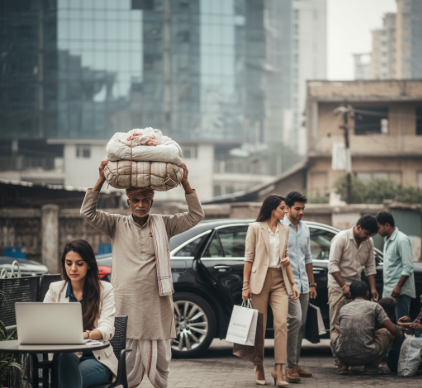India is often described as a land of incredible diversity, a vibrant mosaic of cultures, languages, and traditions. But woven into this complex social fabric is an ancient system of social hierarchy that continues to shape lives, even in the 21st century: the caste system. While officially abolished by law, its ghost lingers, influencing everything from marriage to politics. Understanding modern India requires looking beyond the bustling tech hubs and colorful festivals to grasp the subtle, yet powerful, undercurrent of caste.
The Roots of a Rigid System
To understand its modern form, we need a quick look back. The caste system’s origins are ancient, often traced to the concept of
varna, or social classes, mentioned in sacred texts. This framework traditionally divided society into four main groups, each with a designated role:
- Brahmins: At the top, these were the priests, scholars, and teachers, considered the custodians of knowledge.
- Kshatriyas: The warriors, rulers, and administrators responsible for protecting society.
- Vaishyas: The merchants, traders, and farmers who drove the economy.
- Shudras: The laborers and artisans who served the other three castes.
Outside this four-tiered structure was a fifth group, the
Dalits, previously referred to as “untouchables.” They were assigned tasks considered ritually impure and faced extreme social ostracism. Over centuries, this varna system evolved into a much more complex web of thousands of sub-castes, known as
jatis, often linked to specific occupations and geographies. One’s jati was determined by birth, and it dictated one’s social status, who one could marry, and even with whom one could share a meal.
Caste in the Modern Era: A Legal Ban, A Social Reality
When India gained independence in 1947, its new leaders recognized the profound injustice of the caste system. Spearheaded by Dr. B.R. Ambedkar, a Dalit himself and the architect of the Indian Constitution, the new nation took a radical step. The practice of “untouchability” was outlawed, and caste-based discrimination was made illegal. Furthermore, a system of affirmative action, known as reservations, was introduced to provide quotas in government jobs, educational institutions, and political bodies for historically disadvantaged groups.
The Constitution of India, in Article 15, explicitly prohibits discrimination on grounds of religion, race, caste, sex, or place of birth. This foundational legal principle was designed to dismantle the hierarchical structure of caste. Further articles were added to ensure representation and upliftment for Scheduled Castes (SCs) and Scheduled Tribes (STs).
However, outlawing a practice that has been entrenched for millennia is one thing; erasing it from the collective consciousness is another. This is the central paradox of caste in modern India. While it has no legal standing, it continues to operate as a powerful form of social identity and a determinant of opportunity.
How Caste Plays Out Today
The influence of caste today is not always obvious, especially in the anonymity of large cities. Yet, it manifests in several key areas of life, often in subtle and evolving ways.
Marriage and Family
Perhaps the most resilient bastion of the caste system is marriage. The vast majority of marriages in India are still arranged within the same jati. This practice of
endogamy is a powerful mechanism for preserving caste lines. Newspapers and popular matrimonial websites are filled with ads that explicitly mention caste preferences. While inter-caste love stories are celebrated in Bollywood films, in reality, they can often lead to social ostracism or even violence from families and communities who see it as a transgression.
Politics and Power
In the world’s largest democracy, caste has become an undeniable factor in politics. Political parties often field candidates based on the caste demographics of a constituency, appealing to what are known as “vote banks.” Leaders rally support by invoking caste pride and promising benefits for their specific community. While this has given a political voice to many marginalized groups, it also has the unintended consequence of reinforcing and hardening caste identities rather than dissolving them.
Urban vs. Rural Divide
The experience of caste can differ dramatically between the countryside and the city. In rural villages, where everyone knows everyone’s family history, caste identity is often public knowledge and can still dictate social interactions, housing patterns, and access to resources like water. Discrimination can be overt and direct. In contrast, in urban centers, class and profession often appear to be more important markers of identity. However, caste doesn’t simply disappear. It can surface in subtle ways, such as through surnames, which often signal one’s caste background, leading to discrimination in job interviews or when trying to rent an apartment.
Signs of Change and a Path Forward
Despite its persistence, the grip of the caste system is undeniably weakening in some areas. Urbanization and education are powerful catalysts for change. As people move to cities for work and education, they are exposed to different communities and ideas, breaking down traditional barriers. Economic liberalization has created new opportunities that are not tied to traditional caste-based occupations, allowing for greater social mobility.
It’s crucial to avoid generalizations when discussing the caste system. The experience of caste varies immensely based on region, economic status, and individual circumstances. While progress is being made, many, particularly Dalits and other lower-caste groups, still face significant systemic discrimination and violence.
A growing Dalit rights movement, along with literature, art, and cinema, has been instrumental in challenging historical injustices and asserting a new, empowered identity. Young people, especially in cities, are increasingly pushing back against caste norms, choosing their own partners and friends based on compatibility rather than community. The journey is long and fraught with challenges, but the narrative is slowly changing. The story of caste in modern India is no longer just one of oppression, but also one of resilience, resistance, and a determined struggle for a more equitable future.









